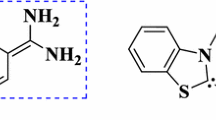Abstract
Corannulene is an unsaturated hydrocarbon composed of fused rings, with one central five-membered ring and five peripheral six-membered rings. Its structure can be considered as a portion of C60. Corannulene is a curved π surface, but unlike C60, it has two accessible different faces: one concave (inside) and one convex (outside). In this work, computational modeling of the binding between alkali metal cations (Li+, Na+, and K+) and corannulene has been performed at the DFT and MP2 levels. Different corannulene···M+ complexes have been studied and the transition states interconnecting local minima were located. The alkali cations can be bound to a five or six membered ring in both faces. At the DFT level, binding to the convex face (outside) is favored relative to the concave face for the three alkali cations studied, as it was previously published. This out preference was found to decrease as cation size increases. At the MP2 level, although a similar trend is found, some different conclusions related to the in/out preference were obtained. According to our results, migration of cations can take place on the convex or on the concave face. Also, there are two ways to transform a concave complex in a convex complex: migration across the edge of corannulene and bowl-to-bowl inversion.



Similar content being viewed by others
Notes
With a calculated dipole moment of 2.23 D for corannulene, and taking into account that interaction between a charge a and a dipole b is given by -q a μ b /r 2 if the dipole is aligned with the charge (α = 0), the following energies were obtained: −26, −19, and −15 kcal mol–1 for the interaction between Li+, Na+, and K+, respectively, with the convex side of corannulene. These values show a similar trend to those of Table 2, though as we have shown recently, the interaction is mainly of inductive character rather than electrostatic [15].
References
Dougherty DA (1996) Science 271:163–168
Ma JC, Dougherty DA (1997) Chem Rev 97:1303–1324
Meyer EA, Castellano RK, Diederich F (2003) Angew Chem Int Ed 42:1210–1250
Roelens S, Torriti R (1998) J Am Chem Soc 120:12443–12452
Bartoli S, Roelens S (1999) J Am Chem Soc 121:11908–11909
Liu T, Gu JD, Tan XJ, Zhu WL, Luo XM, Jiang HL, Ji RY, Chen KX, Silman I, Sussman JL (2001) J Phys Chem A 105:5431–5437
Liu T, Gu JD, Tan XJ, Zhu WL, Luo XM, Jiang HL, Ji RY, Chen KX, Silman I, Sussman JL (2002) J Phys Chem A 106:157–164
Bartoli S, Roelens S (2002) J Am Chem Soc 124:8307–8315
Cheng YH, Liu L, Fu Y, Chen R, Li XS, Guo QX (2002) J Phys Chem A 106:11215–11220
Frash MN, Hopkinson AC, Bohme DK (2001) J Am Chem Soc 123:6687–6695
Priyakumar UD, Sastry GN (2003) Tetrahedron Lett 44:6043–6046
Priyakumar UD, Punnagai M, Mohan GPK, Sastry GN (2004) Tetrahedron 60:3037–3043
Dunbar RC (2002) J Phys Chem A 106:9809–9819
Vijay D, Sakurai H, Subramanian V, Sastry GN (2012) Phys Chem Chem Phys 14:3057–3065
Carrazana-García JA, Rodríguez-Otero J, Cabaleiro-Lago EM (2011) J Phys Chem B 115:2774–2782
Green JR, Dunbar RC (2011) J Phys Chem A 115:4968–4975
Boys F, Bernardi F (1970) Mol Phys 19:553–566
Halkier A, Klopper W, Helgaker T, Jørgensen P, Taylor PR (1999) J Chem Phys 111:9157–9167
Ahlrichs R, Bär M, Häser M, Horn H, Kölmel C (1989) Chem Phys Lett 162:165–169
Sierka M, Hogekamp A, Ahlrichs R (2003) J Chem Phys 118:9136–9148
Deglmann P, May K, Furche F, Ahlrichs R (2004) Chem Phys Lett 384:103–107
Hattig C, Weigend F (2000) J Chem Phys 113:5154–5161
Hattig C, Hald K (2002) Phys Chem Chem Phys 4:2111–2118
Kohn A, Hattig C (2003) J Chem Phys 119:5021–5036
Frisch MJ, Trucks GW, Schlegel HB, Scuseria GE, Robb MA, Cheeseman JR, Scalmani G, Barone V, Mennucci B, Petersson GA, Nakatsuji H, Caricato M, Li X, Hratchian HP, Izmaylov AF, Bloino J, Zheng G, Sonnenberg JL, Hada M, Ehara M, Toyota K, Fukuda R, Hasegawa J, Ishida M, Nakajima T, Honda Y, Kitao O, Nakai H, Vreven T, Montgomery JA, Peralta JE, Ogliaro F, Bearpark M, Heyd JJ, Brothers E, Kudin KN, Staroverov VN, Kobayashi R, Normand J, Raghavachari K, Rendell A, Burant JC, Iyengar SS, Tomasi J, Cossi M, Rega N, Millam JM, Klene M, Knox JE, Cross JB, Bakken V, Adamo C, Jaramillo J, Gomperts R, Stratmann RE, Yazyev O, Austin AJ, Cammi R, Pomelli C, Ochterski JW, Martin RL, Morokuma K, Zakrzewski VG, Voth GA, Salvador P, Dannenberg JJ, Dapprich S, Daniels AD, Farkas Ö, Foresman JB, Ortiz JV, Cioslowski J, Fox DJ (2009) Gaussian 09. Gaussian, Inc, Wallingford, CT
Martin JML (1996) Chem Phys Lett 262:97–104
Petrukhina MA, Andreini KW, Mack J, Scott LT (2005) J Org Chem 70:5713–5716
Josa D, Rodríguez-Otero J, Cabaleiro-Lago EM (2012) Phys Chem Chem Phys 13:21139–21145
Acknowledgments
This research has been supported by the Xunta de Galicia (project INCITE09209103PR). The authors want to express their gratitude to the CESGA (Centro de Supercomputación de Galicia) for the use of their computers.
Author information
Authors and Affiliations
Corresponding author
Electronic supplementary material
Below is the link to the electronic supplementary material.
ESM 1
(PDF 378 kb)
Rights and permissions
About this article
Cite this article
Rellán-Piñeiro, M., Rodríguez-Otero, J., Cabaleiro-Lago, E.M. et al. DFT and MP2 study of the interaction between corannulene and alkali cations. J Mol Model 19, 2049–2055 (2013). https://doi.org/10.1007/s00894-012-1632-8
Received:
Accepted:
Published:
Issue Date:
DOI: https://doi.org/10.1007/s00894-012-1632-8




